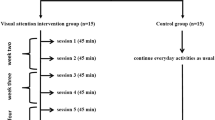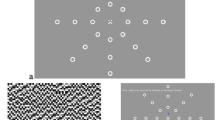Abstract
Exercising with the use of augmented visual feedback for improving functional motor behavior and particularly balance and locomotion has expanded over the late years. As a result, several visual feedback protocols, systems and devices have been developed and commercialized promising an effective means of improving balance function in aging and disease alleviating the risk of falling. A major challenge however, is how efficiently these devices improve balance and prevent falling. Through visually guided practice a specific internal visuo-motor transformation of the practiced visuo-motor task is acquired. Lately however, the generalization of the acquired visuo-motor transformation to other motor tasks has been questioned. In this chapter we review research evidence showing how the human brain uses visual information to control and improve motor performance and postural control in particular and what are the task and stimuli characteristics that optimize visuo-motor learning. Studies examining the effectiveness of visual feedback protocols in older adults’ balance rehabilitation are reviewed and directions for future research and development are discussed in the final section.
Access this chapter
Tax calculation will be finalised at checkout
Purchases are for personal use only
Similar content being viewed by others
References
Miall, R. C., Weir, D. J., & Stein, J. F. (1993). Intermittency in human manual tracking tasks. Journal of Motor Behavior, 25(1), 53–63.
Slifkin, A. B., Vaillancourt, D. E., & Newell, K. M. (2000). Intermittency in the control of continuous force production. Journal of Neurophysiology, 84(4), 1708–1718.
Miall, R. C., Haggard, P. N., & Cole, J. D. (1995). Evidence of a limited visuo-motor memory used in programming wrist movements. Experimental Brain Research, 107(2), 267–280.
Shumway-Cook, A., Anson, D., & Haller, S. (1988). Postural sway biofeedback: Its effect on reestablishing stance stability in hemiplegic patients. Archives of Physical Medicine and Rehabilitation, 69(6), 395–400.
Gil-Gomez, J. A., Llorens, R., Alcaniz, M., & Colomer, C. (2011). Effectiveness of a Wii balance board-based system (eBaViR) for balance rehabilitation: A pilot randomized clinical trial in patients with acquired brain injury. Journal of Neuroengineering and Rehabilitation, 8, 30.
Morton, S. M., & Bastian, A. J. (2004). Prism adaptation during walking generalizes to reaching and requires the cerebellum. Journal of Neurophysiology, 92(4), 2497–2509.
Savin, D. N., & Morton, S. M. (2008). Asymmetric generalization between the arm and leg following prism-induced visuomotor adaptation. Experimental Brain Research, 186(1), 175–182.
Mackrous, I., & Proteau, L. (2007). Specificity of practice results from differences in movement planning strategies. Experimental Brain Research, 183(2), 181–193.
Faugloire, E., Bardy, B. G., & Stoffregen, T. A. (2009). (De)stabilization of required and spontaneous postural dynamics with learning. Journal of Experimental Psychology: Human Perception and Performance, 35(1), 170–187.
Hamman, R. G., Mekjavic, I., Mallinson, A. I., & Longridge, N. S. (1992). Training effects during repeated therapy sessions of balance training using visual feedback. Archives of Physical Medicine and Rehabilitation, 73(8), 738–744.
Heuer, H., & Hegele, M. (2008). Constraints on visuo-motor adaptation depend on the type of visual feedback during practice. Experimental Brain Research, 185(1), 101–110.
Radhakrishnan, S. M., Hatzitaki, V., Vogiannou, A., & Tzovaras, D. (2010). The role of visual cues in the acquisition and transfer of a voluntary postural sway task. Gait & Posture, 32(4), 650–655.
Bausenhart, K. M., de la Rosa, M. D., & Ulrich, R. (2013). Multimodal integration of time. Experimental Psychology, 1–13.
Hinder, M. R., Woolley, D. G., Tresilian, J. R., Riek, S., & Carson, R. G. (2008). The efficacy of colour cues in facilitating adaptation to opposing visuomotor rotations. Experimental Brain Research, 191(2), 143–155.
Danion, F., Duarte, M., & Grosjean, M. (2006). Variability of reciprocal aiming movements during standing: The effect of amplitude and frequency. Gait & Posture, 23(2), 173–179.
Hinder, M. R., Tresilian, J. R., Riek, S., & Carson, R. G. (2008). The contribution of visual feedback to visuomotor adaptation: How much and when? Brain Research, 1197, 123–134.
Duarte, M., & Zatsiorsky, V. M. (2002). Effects of body lean and visual information on the equilibrium maintenance during stance. Experimental Brain Research, 146(1), 60–69.
Klein, B. E., Klein, R., Lee, K. E., & Cruickshanks, K. J. (1998). Performance-based and self-assessed measures of visual function as related to history of falls, hip fractures, and measured gait time. The Beaver Dam Eye Study. Ophthalmology, 105(1), 160–164.
Chapman, G. J., & Hollands, M. A. (2006). Evidence for a link between changes to gaze behaviour and risk of falling in older adults during adaptive locomotion. Gait & Posture, 24(3), 288–294.
Schillings, A. M., Mulder, T., & Duysens, J. (2005). Stumbling over obstacles in older adults compared to young adults. Journal of Neurophysiology, 94(2), 1158–1168.
Dault, M. C., de Haart, M., Geurts, A. C., Arts, I. M., & Nienhuis, B. (2003). Effects of visual center of pressure feedback on postural control in young and elderly healthy adults and in stroke patients. Human Movement Science, 22(3), 221–236.
Hatzitaki, V., & Konstadakos, S. (2007). Visuo-postural adaptation during the acquisition of a visually guided weight-shifting task: Age-related differences in global and local dynamics. Experimental Brain Research, 182(4), 525–535.
Hu, M. H., & Woollacott, M. H. (1994). Multisensory training of standing balance in older adults: I. Postural stability and one-leg stance balance. Journal of Gerontology, 49(2), M52–M61.
Rose, D. J., & Clark, S. (2000). Can the control of bodily orientation be significantly improved in a group of older adults with a history of falls? Journal of American Geriatrics Society, 48(3), 275–282.
Lajoie, Y. (2004). Effect of computerized feedback postural training on posture and attentional demands in older adults. Aging Clinical and Experimental Research, 16(5), 363–368.
Sihvonen, S. E., Sipila, S., & Era, P. A. (2004). Changes in postural balance in frail elderly women during a 4-week visual feedback training: A randomized controlled trial. Gerontology, 50(2), 87–95.
Hatzitaki, V., Amiridis, I. G., Nikodelis, T., & Spiliopoulou, S. (2009). Direction-induced effects of visually guided weight-shifting training on standing balance in the elderly. Gerontology, 55(2), 145–152.
Gouglidis, V., Nikodelis, T., Hatzitaki, V., & Amiridis, I. G. (2011). Changes in the limits of stability induced by weight-shifting training in elderly women. Experimental Aging Research, 37(1), 46–62.
Hatzitaki, V., Voudouris, D., Nikodelis, T., & Amiridis, I. G. (2009). Visual feedback training improves postural adjustments associated with moving obstacle avoidance in elderly women. Gait & Posture, 29(2), 296–299.
Geiger, R. A., Allen, J. B., O’Keefe, J., & Hicks, R. R. (2001). Balance and mobility following stroke: Effects of physical therapy interventions with and without biofeedback/forceplate training. Physical Therapy, 81(4), 995–1005.
Walker, C., Brouwer, B. J., & Culham, E. G. (2000). Use of visual feedback in retraining balance following acute stroke. Physical Therapy, 80(9), 886–895.
Goodale, M. A., & Milner, A. D. (1992). Separate visual pathways for perception and action. Trends in Neurosciences, 15(1), 20–25.
Harbourne, R. T., & Stergiou, N. (2009). Movement variability and the use of nonlinear tools: Principles to guide physical therapist practice. Physical Therapy, 89(3), 267–282.
Heiden, E., & Lajoie, Y. (2010). Games-based biofeedback training and the attentional demands of balance in older adults. Aging Clinical and Experimental Research, 22(5–6), 367–373.
Lamoth, C. J., Caljouw, S. R., & Postema, K. (2011). Active video gaming to improve balance in the elderly. Studies in Health Technology and Informatics, 167, 159–164.
Sveistrup, H., Thornton, M., Bryanton, C., McComas, J., Marshall, S., Finestone, H., et al. (2004). Outcomes of intervention programs using flatscreen virtual reality. Conference Proceedings: IEEE Engineering in Medicine and Biology Society, 7, 4856–4858.
Bamidis, P. D., Vivas, A. B., Styliadis, C., Frantzidis, C., Klados, M., Schlee, W., et al. (2014). A review of physical and cognitive interventions in aging. Neuroscience and Biobehavioral Reviews, 44, 206–220.
Redfern, M. S., Furman, J. M., & Jacob, R. G. (2007). Visually induced postural sway in anxiety disorders. J Anxiety Disord, 21(5), 704–716.
Hatzitaki, V., Stergiou, N., Sofianidis, G., & Kyvelidou, A. (2015). Postural sway and gaze can track the complex motion of a visual target. PLoS One, 10(3), e0119828.
Author information
Authors and Affiliations
Corresponding author
Editor information
Editors and Affiliations
Rights and permissions
Copyright information
© 2015 Springer International Publishing Switzerland
About this chapter
Cite this chapter
Hatzitaki, V. (2015). The Use of Visual Feedback Techniques in Balance Rehabilitation. In: Briassouli, A., Benois-Pineau, J., Hauptmann, A. (eds) Health Monitoring and Personalized Feedback using Multimedia Data. Springer, Cham. https://doi.org/10.1007/978-3-319-17963-6_11
Download citation
DOI: https://doi.org/10.1007/978-3-319-17963-6_11
Publisher Name: Springer, Cham
Print ISBN: 978-3-319-17962-9
Online ISBN: 978-3-319-17963-6
eBook Packages: Computer ScienceComputer Science (R0)




